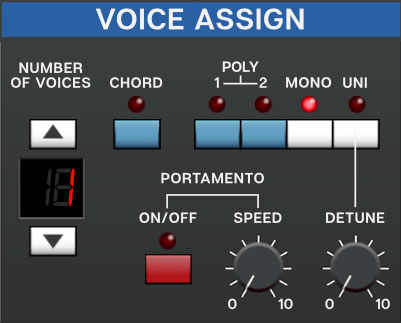
DCO-106 can play up to 16 simultaneous polyphonic voices. The Voice Assign section regulates how these voices are played.
Number Of Voices and LED display- Sets and displays the maximum number of notes that can simultaneously play, from 2 to 16. Increase or decrease the total voices with the up/down arrow keys.
Voice Assign Modes
Poly 1- This is the standard polyphonic mode. If the number of notes played exceeds the current maximum setting, it uses a sophisticated allocation scheme to steal the most recently played notes. In use, this means if you're holding a bass note with your left hand, it won't disappear while playing chords and melodies with your right hand. Suffice to say, running out of polyphonic voices with DCO-106 is far less of concern than with a real Juno synth as DCO-106's polyphony can be set up to 16-voices (compared to a Juno's six voices).
Poly 2- Poly 2's allocation is optimized for use with DCO-106's portamento (glide) function - it does an impressively good job of "knowing" which notes to glide from and to when holding notes while playing melodies (regardless of whether notes are played legato or separately).
Mono- One note can be played a time with one voice sounding. Number Of Voices will change to 1 when Mono is selected. Mono mode uses last-note priority - this means the most recently played note will always sound.
Unison button and Detune knob- One note sounds at a time. Multiple voices will "stack" according to the current Number Of Voices setting. The Uni button should be used in conjunction with the Detune knob which minutely "spreads" the tuning of the oscillators for fat sounds.
Chord Memory- Allows chords to be memorized and played with single keys. To memorize a chord, click the button. The LED flashes to indicate that it's in learn mode. To learn a chord, play up to 16 notes (this is limited by the current Number Of Voices setting); when the last note is released, the LED stops flashing and the chord is memorized. To disable Chord mode, click the button again.
Note that Chord mode isn't just for "chords" per se; it can be used for octaves, fifths, or any desired combination of notes.
Portamento On/Off and Speed knob- Also known as glide, Portamento causes notes to slide smoothly from one pitch to the next. Toggling the switch enables Portamento, and the Speed knob slows glide speed as it's increased. Portamento works in all voice modes; if you'd like to use it polyphonically, we recommend using Poly 2 mode.